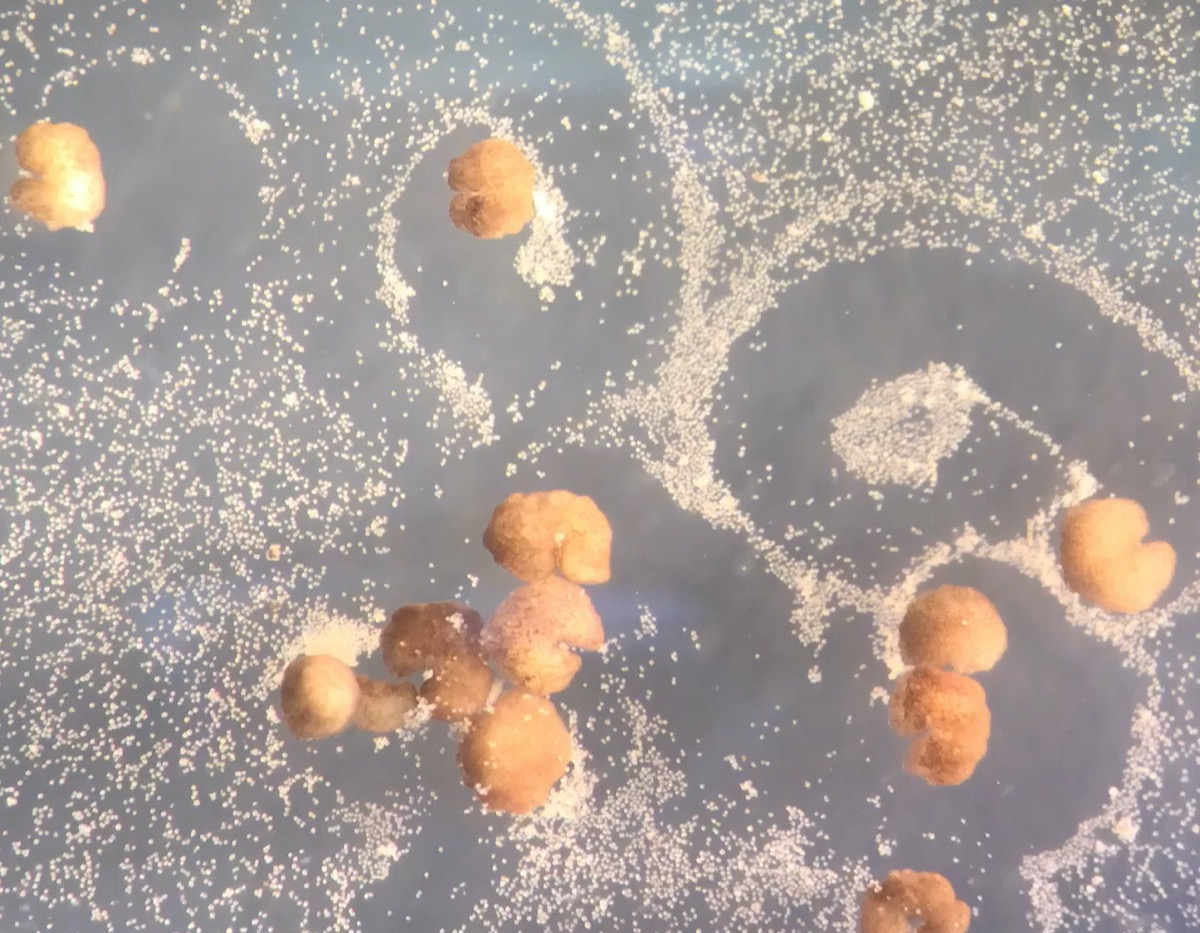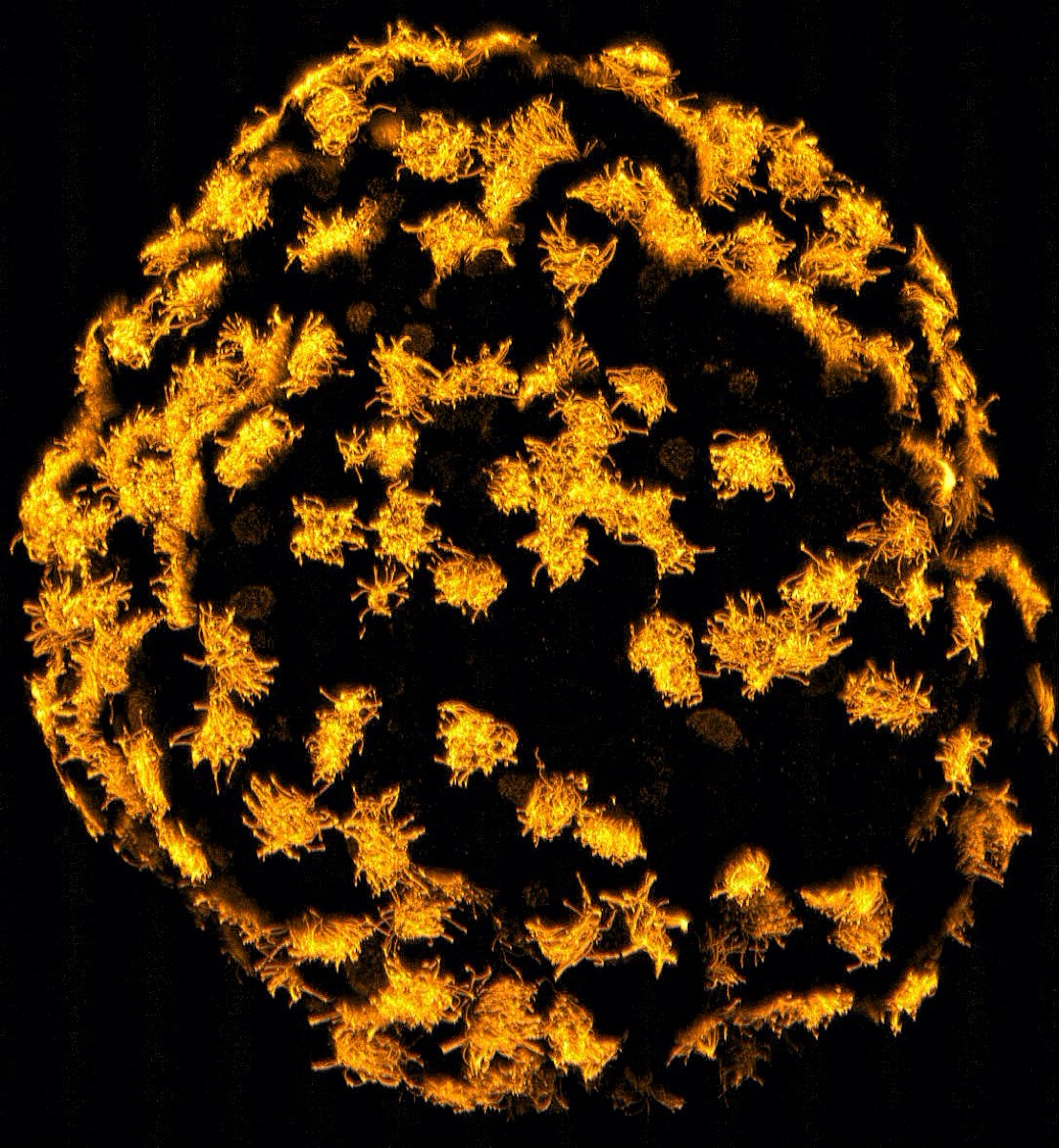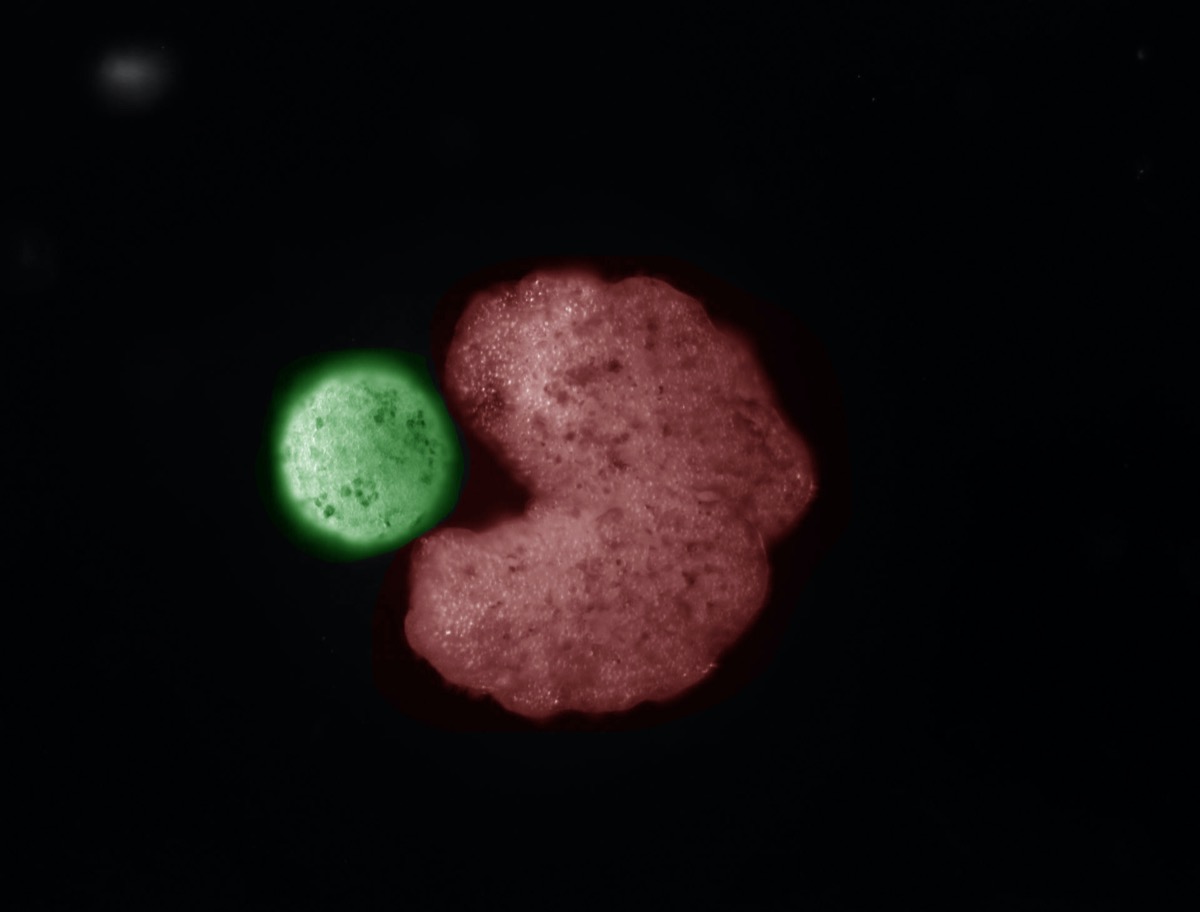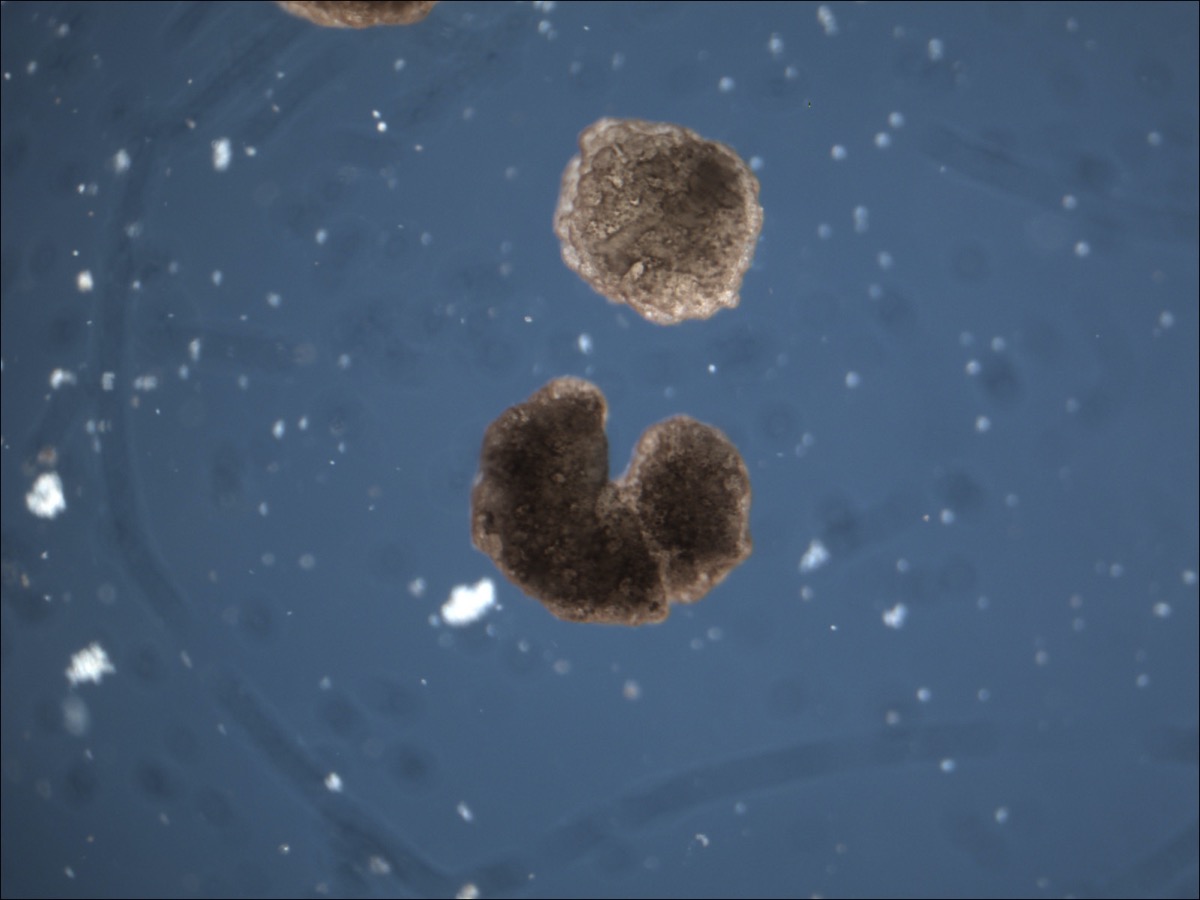Diving Into The Strange World Of Xenobots
9:54 minutes

Just under two years ago, Science Friday reported on the strange world of ‘xenobots’—structures designed by an algorithm and crafted out of living cells taken from frog embryos. Those tiny constructs could slowly wriggle their way across a petri dish, powered by the contractions of frog heart cells. Now, the researchers behind the bots have created a new generation of structures that can swim—and, if provided with additional loose frog skin cells in their dish, organize those cells into clumps that eventually begin to move on their own.
Josh Bongard, a professor of computer science at the University of Vermont and a member of the xenobots research team, joins Ira to talk about the advance in what he likens to living wind-up toys. The work was reported this week in the Proceedings of the National Academy of Sciences. Bongard and colleagues say that they were interested in learning more about self-replicating systems, and the various factors that go into either speeding up or slowing down a system’s ability to self-replicate. They’re also interested in exploring whether such cellular systems might be able to do useful work. However, fear not—Bongard explains that without a ready supply of loose frog skin cells, these bots peter out.
See more video and photos from the research below.
Almost all organisms replicate by growing and then shedding offspring. Some molecules also replicate, but by moving rather than growing: they find and combine building blocks into self copies. Here we show that clusters of cells, if freed from a developing organism, can similarly find and combine loose cells into clusters that look and move like they do, and that this ability does not have to be specifically evolved or introduced by genetic manipulation. Finally, we show that AI can design clusters that replicate better, and perform useful work as they do so. This suggests future technologies may, with little outside guidance, become more useful as they spread, and that life harbors surprising behaviors just below the surface, waiting to be uncovered. Credit: Doug Blackiston and Sam Kriegman
Sculpting two of the AI-generated designs with a microcautery electrode. Credit: Doug Blackiston and Sam Kriegman



A computer simulation was created in which a swarm of nine simulated frog-cell parents (pink) build piles out of simulated adhesive frog stem cells (green) that are strewn across the bottom of a simulated petri dish. The default body shape of parents (and their children) is a sphere: this is what the stem cells “want” to make (due to surface tension) when brought together. The default spherical parents (pink) often fail to self replicate in simulation. Credit: Doug Blackiston and Sam Kriegman
Invest in quality science journalism by making a donation to Science Friday.
Josh Bongard is a professor in the Department of Computer Science at the University of Vermont in Burlington, Vermont.
IRA FLATOW: This is Science Friday. I’m Ira Flatow. About two years ago, we told you about an experimental living robot, a robot fashioned out of cells from a frog embryo. The shapes of the robot were designed by a computer, and then a skilled microsurgeon crafted the robots out of two kinds of frog embryo cells, skin cells, which were mainly for structure, and heart cells, which can contract. They found that the living robots, which they called xenobots, could move around on their own, and potentially perform useful work.
Well, fast forward to this week, and a new generation of xenobots, robots that can now reproduce. Joshua Bongard is a professor in the Department of Computer Science at the University of Vermont, and one of a team of researchers who published this work in the proceedings of the National Academy of Sciences. Welcome back to Science Friday.
JOSHUA BONGARD: Thanks for having me back on, Ira.
IRA FLATOW: So you’ve been busy since two years ago when we spoke. You had these little cell things that looked like Pac-Man, that kind of wiggled around in a dish. How did you get from that to self-reproduction?
JOSHUA BONGARD: Yeah, it’s a great question. So when I was here two years ago, I introduced you, on behalf of our team, to the xenobots. At that time, they walked along the bottom of the dish using heart muscle cells. In March of this year, we published a second paper where we showed that xenobots could swim. They grow small hairs called cilia on their surfaces, and that allows them to move through the water in the Petri dish faster than our walking bots.
In that second experiment, we sprinkled some very small pellets into the dish, as well. And we put a swarm of xenobots together to see what they would do. They ended up moving around like very small bulldozers. And as a result of their action, they pushed these pellets into small piles.
At that point, our team asked each other what would happen if we replace those pellets with more skin cells. So now we sprinkled the dish with frog skin cells, loose in the dish. We put nine xenobots back in the dish. They pushed those cells into piles. And after five days, those piles began moving, and thus were born child xenobots.
IRA FLATOW: Whoa. How did that happen? What did they do? What went on in that dish?
JOSHUA BONGARD: Yeah, so what happened is when some of these frog cells were pushed into piles, if there were enough of them, if there was, on average, about more than 50 cells in a pile, they would gradually adhere to one another. Cells tend to be sticky under certain circumstances. So the pile would sort of become welded together. And the cells would talk to one another. What language they’re using we don’t know. That’s something our group and others are trying to figure out. But whatever those cells were saying to one another, they agreed to grow cilia, these small hairs on their surfaces. And if that pile was large enough and had enough cilia, the pile would start to move.
IRA FLATOW: So they didn’t really split apart and reproduce that way. They reproduced with the new stuff that you put in there.
JOSHUA BONGARD: That’s right. So we refer to this technically as kinematic self-replication, which is a bit of a mouthful. The kinematic means that they make offspring by moving. They act like bulldozers, make piles, and those piles start moving. And we refer to this as replication, rather than reproduction. Replication is sort of the umbrella term for anyone or anything that makes copies of itself. So this is a form of replication, not the usual reproductive form of propagating oneself you see in nature, like trees that grow seeds or mammals that grow babies inside themselves.
IRA FLATOW: Do they look and behave like the original xenobots?
JOSHUA BONGARD: They look a little bit like them. You referred to the Pac-Man shape of these. In the second part of the paper, we actually asked an AI to design xenobots that would be more replicative. And what I mean by that is the AI dreamed up a particular shape, which ended up being this Pac-Man shape. And if you put nine of these Pac-Man in the Petri dish, they push more cells in their mouths and end up making larger piles. Those larger piles mature into larger children, which end up pushing more cells and making grandchildren, great-grandchildren, and great-great-grandchildren.
IRA FLATOW: Now, is this assembly process deliberate, or is it just random chance that they make these clumps?
JOSHUA BONGARD: As scientists, we need to be skeptical. So our assumption is that it’s just random action. So although we somewhat tongue in cheek refer to these xenobots as bots or robots, they’re acting more like mechanical windup toys. They just move through the dish and happen to push cells into piles.
That being said, cells themselves are incredibly complex and smart machines. So there may be some agency going on in these swarms of replicating xenobots. But we haven’t investigated that yet.
IRA FLATOW: You originally were using frog skin cells and heart cells. And of course, these don’t have cilia. Do you have a reason to explain how they developed cilia later on?
JOSHUA BONGARD: Yeah, this is one of the surprising pieces of this study and the previous one. There are certain conditions under which these xenobots will grow cilia. In the normal frog, the frog grows cilia on its skin, and uses that to sort of brush material and particulate matter off its body. Here, we’re kind of causing the xenobots to adapt the use of cilia for something else, which in this case is propulsion.
IRA FLATOW: Are there parts of them that are original frogs’ eggs and could mature into frogs?
JOSHUA BONGARD: So in all of the xenobot work we’ve done so far, this is all genetically unmodified material. If you break open the cell and read out the DNA, the DNA is indistinguishable from normal frog. One of the interesting findings of this from a scientific perspective is that apparently frog DNA doesn’t encode just frog. Under just the right environmental conditions, like the ones we’ve set up here, they can mature into very different stable forms and function that are very far from normal frog.
IRA FLATOW: Are you saying you can get some weird kind of creature instead of a frog that would come out of this?
JOSHUA BONGARD: Yes, absolutely. That’s what we’re saying. The xenobots look and act completely different from normal frogs. They’re millimeter-sized, and they push cells to make copies of themselves. This is not something that normal frog does. So this is actually a continuing story unfolding in Mike Levin’s lab. Mike Levin is my biology colleague on this project. And the Levin lab has done a lot of important work on sort of rethinking through what DNA actually does. It doesn’t strictly encode organisms. It encodes something else.
IRA FLATOW: Something else.
JOSHUA BONGARD: So to unpack that idea a little bit more, DNA somehow directs how cells organize themselves in response to certain environmental conditions. A frog cell under normal froggy conditions will develop into a frog. But if you rearrange some of that material, if you liberate cells from the normal embryo and put them in very strange, alien surroundings or an environment they didn’t experience normally, they develop into something else.
IRA FLATOW: And if that something else we’re to get out into the wild, back into a pond, let’s say, could they continue to develop?
JOSHUA BONGARD: That’s a great question. So we’re dealing with self-replicating systems here. We have to be very careful. There are a lot of animal welfare rules in force here. We’re very careful about lab safety. This is not something that’s going to escape from the lab and grow out of control. If we simply don’t make dissociated loose frog skin cells available to these xenobots, they stop replicating.
IRA FLATOW: Now, I understand that since this was published, you’ve heard lots of questions about why, why do this, whether this was something that you should do. How do you answer that?
JOSHUA BONGARD: That’s a great question. For very good reasons, we understand that a lot of people are apprehensive, particularly at the moment, about small biological things that replicate out of control. And that’s part of the rationale behind this work. We, as a society, do not understand how to control things that replicate. We would like to slow the spread of bad things like COVID, and we would like to learn how to spread useful things like vaccines to those who want it faster. We’re not very good at accelerating or suppressing replicating systems.
IRA FLATOW: Where do you go from here? What’s the next step in your process with these xenobots?
JOSHUA BONGARD: One thing we’d like to do is automate the fabrication of xenobots. We’d like to create biofabrication facilities that can print out or make the billions of designs that our AI has already come up with. We’re also looking at building biobots out of other cell types taken from other organisms. There’s no reason we need to stay with frogs. It may become possible in the not too distant future that we could create biobots out of human cells, and start to explore potential medical applications.
IRA FLATOW: No pushback from there, I imagine.
JOSHUA BONGARD: I would imagine.
IRA FLATOW: Thank you very much, Joshua, for taking time to be with us today.
JOSHUA BONGARD: Of course. It was my pleasure.
IRA FLATOW: Joshua Bongard, professor in the Department of Computer Science at the University of Vermont.
Copyright © 2021 Science Friday Initiative. All rights reserved. Science Friday transcripts are produced on a tight deadline by 3Play Media. Fidelity to the original aired/published audio or video file might vary, and text might be updated or amended in the future. For the authoritative record of Science Friday’s programming, please visit the original aired/published recording. For terms of use and more information, visit our policies pages at http://www.sciencefriday.com/about/policies/
As Science Friday’s director and senior producer, Charles Bergquist channels the chaos of a live production studio into something sounding like a radio program. Favorite topics include planetary sciences, chemistry, materials, and shiny things with blinking lights.
Ira Flatow is the founder and host of Science Friday. His green thumb has revived many an office plant at death’s door.